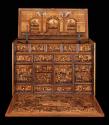Advanced Search
Table Cabinet
German (Augsburg)
about 1580–1600
Medium/Technique
Wood; oak and pine veneered with maple, cherry, beech, and other woods, gilt brass, iron
Dimensions
57 x 92.5 x 41 cm (22 7/16 x 36 7/16 x 16 1/8 in.)
Credit Line
Henry H. and Zoe Oliver Sherman Fund and Museum purchase with funds donated anonymously
Accession Number2001.706
NOT ON VIEW
CollectionsEurope
ClassificationsFurniture – Case furniture and boxes
Beginning in the mid-sixteenth century, cabinetmakers in the south German city of Augsburg specialized in table cabinets intended for the storage of small, precious objects such as exotic shells, medals, jewelry, and statuettes. These luxury cabinets were decorated entirely with colorful marquetry depicting fantastic townscapes, classical ruins, rabbits, dogs, cloaked figures, and a range of ornamental motifs drawn from contemporary German prints.
DescriptionThe table cabinet (Schreibtisch) is composed of a drop front and lid which when open reveal eight drawers and four small doors. The underlying carcase is constructed of oak with an inner carcase composed of a softwood. The divides between the drawers and compartments are also a softwood faced on the front edges with hardwood veneers. The carcase wood of the drop front and lid is a softwood. All surfaces of the chest including the interior drawers and doors are decorated with a combination of marquetry and intarsia composed of a variety of European woods. The distinctive material used on this cabinet is the green mottled colored veneer which resembles marble. This material is produced by gluing together wood shavings of different woods to form a composite which is then cut to form a veneer in a technique called "Spänemarmorierung" which is often found on Augsburg cabinets. The green wood on the inside of the cabinet is probably a green fungus stained wood which has been previously reported on Augsburg cabinets.
ProvenancePrivate collection, Southern France [see note 1]; By 2001, Galerie Neuse, Bremen, Germany; 2001 sold by Galerie Neuse to the MFA. (Accession date: December 12, 2001)
NOTES:
[1] In a letter to the MFA, September 21, 2001, Volker Wurster, dealer of the Galerie Neuse, writes that the family from whom the gallery purchased the cabinet claims it remained within the family and that no change of ownership took place between 1933-1945.
NOTES:
[1] In a letter to the MFA, September 21, 2001, Volker Wurster, dealer of the Galerie Neuse, writes that the family from whom the gallery purchased the cabinet claims it remained within the family and that no change of ownership took place between 1933-1945.











